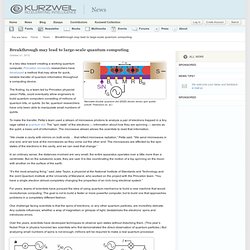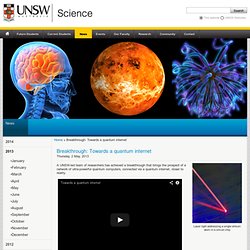

Quantum Computing Breakthrough. Unconditional quantum teleportation between distant solid-state quantum bits. Quantum world record smashed. 14-Nov-2013 [ Print | E-mail ] Share [ Close Window ] Contact: University of Oxford Press Officepress.office@admin.ox.ac.uk 44-186-528-3877University of Oxford A normally fragile quantum state has been shown to survive at room temperature for a world record 39 minutes, overcoming a key barrier towards building ultrafast quantum computers.

An international team including Stephanie Simmons of Oxford University, UK, report in this week's Science a test performed by Mike Thewalt of Simon Fraser University, Canada, and colleagues. In the experiment the team raised the temperature of a system, in which information is encoded in the nuclei of phosphorus atoms in silicon, from -269 °C to 25 °C and demonstrated that the superposition states survived at this balmy temperature for 39 minutes – outside of silicon the previous record for such a state's survival at room temperature was around two seconds. There is still some work ahead before the team can carry out large-scale quantum computations.
A world first! Success at complete quantum teleportation. Furusawa group at the University of Tokyo has succeeded in demonstrating complete quantum teleportation of photonic quantum bits by a hybrid technique for the first time worldwide.

In 1997, quantum teleportation of photonic quantum bits was achieved by a research team at Innsbruck University in Austria. However, such quantum teleportation couldn't be used for information processing, because measurement was required after transport, and the transport efficiency was low. Approaching the Quantum Computing Evolutionary Threshold. “Back in 2007, a company called D-Wave made waves by claiming it had built a 16-bit quantum computer at a time when most academic labs could only manage a handful of bits.
What they demonstrated, however, wasn’t a quantum computer in the sense that most people use the term. The company has since started calling its device a ‘quantum optimizer.’ Although it’s not a general-purpose quantum computer, the hardware does seem to be capable of tackling some computationally hard challenges. The actual performance of the hardware and the software that controls it (called, somewhat ironically, the Black Box) hasn’t really been described in detail. Nasa buys into 'quantum' computer. A $15m computer that uses "quantum physics" effects to boost its speed is to be installed at a Nasa facility.

It will be shared by Google, Nasa, and other scientists, providing access to a machine said to be up to 3,600 times faster than conventional computers. Unlike standard machines, the D-Wave Two processor appears to make use of an effect called quantum tunnelling. This allows it to reach solutions to certain types of mathematical problems in fractions of a second. Effectively, it can try all possible solutions at the same time and then select the best. Google wants to use the facility at Nasa's Ames Research Center in California to find out how quantum computing might advance techniques of machine learning and artificial intelligence, including voice recognition.
University researchers will also get 20% of the time on the machine via the Universities Space Research Agency (USRA). Nasa will likely use the commercially available machine for scheduling problems and planning. D-Wave 16 bit computer solves TSP in seconds. D-Wave Systems. D-Wave Systems, Inc. is a quantum computing company, based in Burnaby, British Columbia.

On May 11, 2011, D-Wave System announced D-Wave One, labeled "the world's first commercially available quantum computer," operating on a 128 qubit chip-set[1] using quantum annealing [2][3][4][5] to solve optimization problems. Breakthrough may lead to large-scale quantum computing. Nanowire-double quantum dot (DQD) device stores spin qubits (credit: Petersson et. al.)

In a key step toward creating a working quantum computer, Princeton University researchers have developed a method that may allow for quick, reliable transfer of quantum information throughout a computing device. The finding, by a team led by Princeton physicist Jason Petta, could eventually allow engineers to build quantum computers consisting of millions of quantum bits, or qubits. So far, quantum researchers have only been able to manipulate small numbers of qubits.
Researchers create single-atom silicon-based quantum computer. A team of Australian engineers is claiming it has made the first working quantum bit (qubit) fashioned out of a single phosphorous atom, embedded on a conventional silicon chip.

This breakthrough stems all the way back to 1998, when Bruce Kane — then a University of New South Wales (UNSW) professor — published a research paper on the possibility of phosphorous atoms, suspended in ultra-pure silicon, being used as qubits. For 14 years, UNSW has been working on the approach — and today, it has finally turned theory into practice. To create this quantum computer chip, the Australian engineers created a silicon transistor so small that “electrons have to travel along it one after the other.” A single phosphorous atom is then implanted into the silicon substrate, right next to the transistor. The transistor only allows electricity to flow through it if one electron from the phosphorus atom jumps to an “island” in the middle of the transistor. How To Make a Quantum Bit. Breakthrough: Towards a quantum internet. A UNSW-led team of researchers has achieved a breakthrough that brings the prospect of a network of ultra-powerful quantum computers, connected via a quantum internet, closer to reality.

The team is the first in the world to have detected the spin, or quantum state, of a single atom using a combined optical and electrical approach. The study is a collaboration between researchers from the ARC Centre of Excellence for Quantum Computation and Communication Technology based at UNSW, the Australian National University and the University of Melbourne. It is published in the journal Nature. UNSW’s Professor Sven Rogge said the technical feat was achieved with a single atom of erbium – a rare earth element commonly used in communications - embedded in silicon. “We have the best of both worlds with our combination of an electrical and optical system. “Using light to transfer information in the quantum state is easier than doing it electrically. Media Contacts: (Sven also speaks Dutch and German)